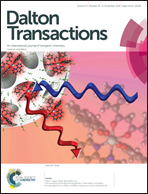Coordination, microprotonation equilibria and conformational changes of myo-inositol hexakisphosphate with pertinence to its biological function†
Abstract
Within all the eukaryotic cells there is an important group of biomolecules that has been potentially related to signalling functions: the myo-inositol phosphates (InsPs). In nature, the most abundant member of this family is the so called InsP6 (phytate, L12−), for which our group has strived in the past to elucidate its intricate chemical behaviour. In this work we expand on our earlier findings, shedding light on the inframolecular details of its protonation and complexation processes. We evaluate systematically the chemical performance of InsP6 in the presence and absence of alkali and alkaline earth metal ions, through 31P NMR measurements, in a non-interacting medium and over a wide pH range. The analysis of the titration curves by means of a model based on the cluster expansion method allows us to describe in detail the distribution of the different protonated microspecies of the ligand. With the aid of molecular modelling tools, we assess the energetic and geometrical characteristics of the protonation sequence and the conformational transition suffered by InsP6 as the pH changes. By completely characterizing the protonation pattern, conformation and geometry of the metal complexes, we unveil the chemical and structural basis behind the influence that the physiologically relevant cations, Na+, K+, Mg2+ and Ca2+ have over the phytate chemical reactivity. This information is essential in the process of gaining reliable structural knowledge about the most important InsP6 species in the in vitro and in vivo experiments, and how these features modulate their probable biological functions.


 Please wait while we load your content...
Please wait while we load your content...